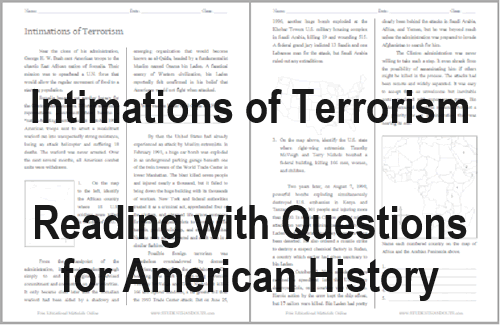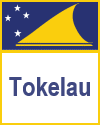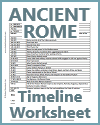| Intimations of Terrorism Reading with Questions |
|---|
| www.studenthandouts.com ↣ American History ↣ American History Readings |
|
Near the close of his administration, George H. W. Bush sent American troops to the chaotic East African nation of Somalia. Their mission was to spearhead a U.N. force that would allow the regular movement of food to a starving population.
Somalia became yet another legacy for the Clinton administration. Efforts to establish a representative government there became a “nation-building” enterprise. In October 1993, American troops sent to arrest a recalcitrant warlord ran into unexpectedly strong resistance, losing an attack helicopter and suffering 18 deaths. The warlord was never arrested. Over the next several months, all American combat units were withdrawn.  From the standpoint of the administration, it seemed prudent enough simply to end a marginal, ill-advised commitment and concentrate on other priorities. It only became clear later that the Somalian warlord had been aided by a shadowy and emerging organization that would become known as al-Qaida, headed by a fundamentalist Muslim named Osama bin Laden. A fanatical enemy of Western civilization, bin Laden reportedly felt confirmed in his belief that Americans would not fight when attacked.
From the standpoint of the administration, it seemed prudent enough simply to end a marginal, ill-advised commitment and concentrate on other priorities. It only became clear later that the Somalian warlord had been aided by a shadowy and emerging organization that would become known as al-Qaida, headed by a fundamentalist Muslim named Osama bin Laden. A fanatical enemy of Western civilization, bin Laden reportedly felt confirmed in his belief that Americans would not fight when attacked.
By then the United States had already experienced an attack by Muslim extremists. In February 1993, a huge car bomb was exploded in an underground parking garage beneath one of the twin towers of the World Trade Center in lower Manhattan. The blast killed seven people and injured nearly a thousand, but it failed to bring down the huge building with its thousands of workers. New York and federal authorities treated it as a criminal act, apprehended four of the plotters, and obtained life prison sentences for them. Subsequent plots to blow up traffic tunnels, public buildings, and even the United Nations were all discovered and dealt with in a similar fashion. Possible foreign terrorism was nonetheless overshadowed by domestic terrorism, primarily the Oklahoma City bombing. The work of right-wing extremists Timothy McVeigh and Terry Nichols, it killed 166 and injured hundreds, a far greater toll than the 1993 Trade Center attack. But on June 25, 1996, another huge bomb exploded at the Khobar Towers U.S. military housing complex in Saudi Arabia, killing 19 and wounding 515. A federal grand jury indicted 13 Saudis and one Lebanese man for the attack, but Saudi Arabia ruled out any extraditions. Two years later, on August 7, 1998, powerful bombs exploding simultaneously destroyed U.S. embassies in Kenya and Tanzania, killing 301 people and injuring more than 5,000. In retaliation Clinton ordered missile attacks on terrorist training camps run by bin Laden in Afghanistan, but they appear to have been deserted. He also ordered a missile strike to destroy a suspect chemical factory in Sudan, a country which earlier had given sanctuary to bin Laden. On October 12, 2000, suicide bombers rammed a speedboat into the U.S. Navy destroyer Cole, on a courtesy visit to Yemen. Heroic action by the crew kept the ship afloat, but 17 sailors were killed. Bin Laden had pretty clearly been behind the attacks in Saudi Arabia, Africa, and Yemen, but he was beyond reach unless the administration was prepared to invade Afghanistan to search for him. The Clinton administration was never willing to take such a step. It even shrank from the possibility of assassinating him if others might be killed in the process. The attacks had been remote and widely separated. It was easy to accept them as unwelcome but inevitable costs associated with superpower status. Bin Laden remained a serious nuisance, but not a top priority for an administration that was nearing its end. Click here to print. This worksheet has lots of map work, since students tend to be largely unfamiliar with the regions of Africa and the Middle East which are covered in the text. Answer Key: (1) On map; (2) Osama bin Laden; (3) On map. Map: (1) Saudi Arabia; (2) Yemen; (3) Somalia; (4) Kenya, (5) Tanzania. |
 |  |  |  |  |  |
| UNIT I: | Early America | UNIT IX: | Discontent and Reform | ||
| UNIT II: | Colonial Period | UNIT X: | War, Prosperity, and Depression | ||
| UNIT III: | American Revolution | UNIT XI: | New Deal and World War II | ||
| UNIT IV: | New National Government | UNIT XII: | Postwar America | ||
| UNIT V: | Westward Expansion | UNIT XIII: | Decades of Change | ||
| UNIT VI: | Sectional Conflict | UNIT XIV: | New Conservatism | ||
| UNIT VII: | Civil War and Reconstruction | UNIT XV: | Into the Twenty-first Century | ||
| UNIT VIII: | Growth and Transformation | UNIT XVI: | Polarization and Deglobalization |
| www.studenthandouts.com ↣ American History ↣ American History Readings |








